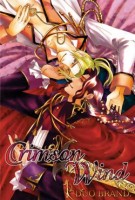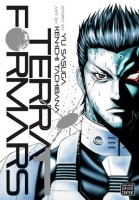My News and Reviews
It wasn’t entirely intentional, but last week Experiments in Manga ended up being full of Vertical reviews. (And by full, I mean that two reviews were posted.) The first was of Fumi Yoshinaga’s gay slice-of-life and food manga What Did You Eat Yesterday?, Volume 3. With each volume that is released, I fall in love with the series a little more. I also reviewed Yoshikazu Yasuhiko’s Mobile Suit Gundam: The Origin, Volume 6: To War which continues to delve into the pasts of the characters and the war between the Earth Federation and the Principality of Zeon. The volume also features Char quite a bit. (I’ll admit, that made me happy.)
Elsewhere online, The Lobster Dance posted the seventh and final part of “Revealing and Concealing Identities: Cross-Dressing in Anime and Manga.” Kathryn Hemmann, the co-author, has a nice roundup and summary of the multi-part essay, and Leah has some final comments of her own as well. San Diego Comic Con was last week, which means the winners of the 2014 Eisner Awards were named (spoilers: Osamu Tezuka and Hayao Miyazaki were honored) and new manga licenses from Drawn & Quarterly, Kodansha Comics, and Udon Entertainment were announced. Also, the list from the Best & Worst Manga panel has been posted, with more commentary on the choices planned to be posted at a later date.
Quick Takes
 9 Faces of Love by Wann. As can probably be gathered from its title, 9 Faces of Love is a collection of nine short manhwa dealing with themes of love and the meaning of love. 9 Faces of Love is the second volume in Netcomics’ Manhwa Novella Collection series which is meant to feature short works by prominent Korean creators. I hadn’t previously read any of Wann’s works, but I’d definitely be interested in reading more; I really enjoyed 9 Faces of Love. It’s an excellent collection of short manhwa selected from Wann’s work between 1998 and 2005. Most of the stories deal with romantic love, but a few of them also deal with friendship and familial love. I initially picked up the volume for the android story “Automaton,” which happily ended up being quite good. While they deal with similar themes, there is a nice variety to the stories in 9 Faces of Love. Many incorporate science fiction, fantasy, or horror elements while others are more firmly grounded in reality. Some are sweet, some are sad, and some are actually somewhat disconcerting.
9 Faces of Love by Wann. As can probably be gathered from its title, 9 Faces of Love is a collection of nine short manhwa dealing with themes of love and the meaning of love. 9 Faces of Love is the second volume in Netcomics’ Manhwa Novella Collection series which is meant to feature short works by prominent Korean creators. I hadn’t previously read any of Wann’s works, but I’d definitely be interested in reading more; I really enjoyed 9 Faces of Love. It’s an excellent collection of short manhwa selected from Wann’s work between 1998 and 2005. Most of the stories deal with romantic love, but a few of them also deal with friendship and familial love. I initially picked up the volume for the android story “Automaton,” which happily ended up being quite good. While they deal with similar themes, there is a nice variety to the stories in 9 Faces of Love. Many incorporate science fiction, fantasy, or horror elements while others are more firmly grounded in reality. Some are sweet, some are sad, and some are actually somewhat disconcerting.
 All You Need is Kill adapted by Nick Mamatas, illustrated by Lee Ferguson and Fajar Buana. A few years ago I read Hiroshi Sakurazaka’s All You Need Is Kill light novel and greatly enjoyed it. So I was rather curious when Haikasoru announced a graphic novel adaptation, the release conveniently timed to coincide with the Hollywood film adaptation Edge of Tomorrow. (Granted, I was much more interested in Takeshi Obata’s All You Need Is Kill manga which has now also been licensed.) Sadly, I was rather disappointed with the graphic novel. I’m not sure that anyone who hasn’t read the original would be able to follow the comic very easily or make sense of the importance of some of the scenes that were included. For example, I loved the umeboshi eating contest in the novel, but in the comic it’s difficult to realize that that’s what’s going on or why it matters. Romantic elements are introduced at the end more as an afterthought in an effort to neatly tie things together, but it’s a little too late by that point. For the most part the artwork was decent, but the battle suit design left something to be desired. I did like the color palette used, though. My copy of the graphic novel also had a printing error. At least I’m assuming it was an error—one of the signatures was repeated. Though, I suppose that does emphasize the plot’s time loop.
All You Need is Kill adapted by Nick Mamatas, illustrated by Lee Ferguson and Fajar Buana. A few years ago I read Hiroshi Sakurazaka’s All You Need Is Kill light novel and greatly enjoyed it. So I was rather curious when Haikasoru announced a graphic novel adaptation, the release conveniently timed to coincide with the Hollywood film adaptation Edge of Tomorrow. (Granted, I was much more interested in Takeshi Obata’s All You Need Is Kill manga which has now also been licensed.) Sadly, I was rather disappointed with the graphic novel. I’m not sure that anyone who hasn’t read the original would be able to follow the comic very easily or make sense of the importance of some of the scenes that were included. For example, I loved the umeboshi eating contest in the novel, but in the comic it’s difficult to realize that that’s what’s going on or why it matters. Romantic elements are introduced at the end more as an afterthought in an effort to neatly tie things together, but it’s a little too late by that point. For the most part the artwork was decent, but the battle suit design left something to be desired. I did like the color palette used, though. My copy of the graphic novel also had a printing error. At least I’m assuming it was an error—one of the signatures was repeated. Though, I suppose that does emphasize the plot’s time loop.
 Crimson Wind by Duo Brand. A follow-up to White Guardian, Crimson Wind starts out as a sequel but really ends up being more of a prequel. The majority of the manga explores the backstories of General Sei and Baron Touri and their relationship with each other. Except for his attractive character design, I didn’t like Touri much at all in White Guardian and I like him even less in Crimson Wind. He’s a rapist and possessive, resorting to drugging the object of his desire when coercion and force isn’t enough to get what he wants. It’s not at all romantic even though Sei ends up falling for him. Most of the court intrigue and politics that made White Guardian interesting have been dropped in Crimson Spell; only the dubious love story remains. I would have much rather have seen the tale of how Sei became disillusioned and unhappy with the kingdom he pledged his life to protect. I may not have enjoyed the main story of Crimson Wind, however I really liked the short side story “Never Ever” which concludes the volume and features two completely different character who actually care for and respect each other.
Crimson Wind by Duo Brand. A follow-up to White Guardian, Crimson Wind starts out as a sequel but really ends up being more of a prequel. The majority of the manga explores the backstories of General Sei and Baron Touri and their relationship with each other. Except for his attractive character design, I didn’t like Touri much at all in White Guardian and I like him even less in Crimson Wind. He’s a rapist and possessive, resorting to drugging the object of his desire when coercion and force isn’t enough to get what he wants. It’s not at all romantic even though Sei ends up falling for him. Most of the court intrigue and politics that made White Guardian interesting have been dropped in Crimson Spell; only the dubious love story remains. I would have much rather have seen the tale of how Sei became disillusioned and unhappy with the kingdom he pledged his life to protect. I may not have enjoyed the main story of Crimson Wind, however I really liked the short side story “Never Ever” which concludes the volume and features two completely different character who actually care for and respect each other.
 Showa: A History of Japan, 1939-1944 by Shigeru Mizuki. With this volume of Showa: A History of Japan the manga begins to cover history that I’m a little more familiar with—the Pacific War. While the factual recounting of the events that led up to the war and the war itself is well told, what makes the series particularly engaging is the incorporation of Mizuki’s own experiences as a student and eventually as a drafted soldier during the time period. The artwork in Showa: A History of Japan easily slips between photorealism and more stylized drawings to very good effect. Mizuki’s illustrations of naval and sea battles are particularly impressive and he uses some very interesting two-page layouts for many of them. He conveys the reality of war but doesn’t glorify it or the numerous deaths, treating the combatants of both sides of the conflict with respect. Mizuki’s Eisner-winning, semi-autobiographical Onward Towards Our Noble Deaths (also available from Drawn & Quarterly), which deals with a similar time period and story, makes an excellent companion to this volume of Showa: A History of Japan.
Showa: A History of Japan, 1939-1944 by Shigeru Mizuki. With this volume of Showa: A History of Japan the manga begins to cover history that I’m a little more familiar with—the Pacific War. While the factual recounting of the events that led up to the war and the war itself is well told, what makes the series particularly engaging is the incorporation of Mizuki’s own experiences as a student and eventually as a drafted soldier during the time period. The artwork in Showa: A History of Japan easily slips between photorealism and more stylized drawings to very good effect. Mizuki’s illustrations of naval and sea battles are particularly impressive and he uses some very interesting two-page layouts for many of them. He conveys the reality of war but doesn’t glorify it or the numerous deaths, treating the combatants of both sides of the conflict with respect. Mizuki’s Eisner-winning, semi-autobiographical Onward Towards Our Noble Deaths (also available from Drawn & Quarterly), which deals with a similar time period and story, makes an excellent companion to this volume of Showa: A History of Japan.
 Terra Formars, Volume 1 written by Yu Sasuga and illustrated by Ken-ichi Tachibana. I have a peculiar love for Mars, and so when a manga has anything to do with the planet, however slight, it immediately catches my attention. I was looking forward to Terra Formars and really liked its basic premise. Efforts to terraform Mars using moss and cockroaches over hundreds of years has largely been successful, but now humans have a bit of a bug problem to deal with seeing as the cockroaches have evolved into a sentient race. Genetic experimentation has also allowed human and insect DNA to be combined, creating humans with bug-inspired superpowers. (Admittedly ridiculous, but kind of cool.) Terra Formars is an extremely violent and action-heavy manga requiring a tremendous amount of suspension of disbelief from it readers. There were parts of the manga that I loved, like the fight sequence paired with biblical verses about locusts. However, I really dislike the design of the cockroaches (inspired by Homo erectus), and not just because they’re unintentionally reminiscent of racist caricatures. They seem more mammalian than insectoid and feel out-of-place art-wise. At this point I’m torn over the series, but I’ll probably give it another volume or two to see what direction it takes.
Terra Formars, Volume 1 written by Yu Sasuga and illustrated by Ken-ichi Tachibana. I have a peculiar love for Mars, and so when a manga has anything to do with the planet, however slight, it immediately catches my attention. I was looking forward to Terra Formars and really liked its basic premise. Efforts to terraform Mars using moss and cockroaches over hundreds of years has largely been successful, but now humans have a bit of a bug problem to deal with seeing as the cockroaches have evolved into a sentient race. Genetic experimentation has also allowed human and insect DNA to be combined, creating humans with bug-inspired superpowers. (Admittedly ridiculous, but kind of cool.) Terra Formars is an extremely violent and action-heavy manga requiring a tremendous amount of suspension of disbelief from it readers. There were parts of the manga that I loved, like the fight sequence paired with biblical verses about locusts. However, I really dislike the design of the cockroaches (inspired by Homo erectus), and not just because they’re unintentionally reminiscent of racist caricatures. They seem more mammalian than insectoid and feel out-of-place art-wise. At this point I’m torn over the series, but I’ll probably give it another volume or two to see what direction it takes.
 Gin Tama, Episodes 50-74 directed by Shinji Takamatsu. It’s been a while since I’ve watched any of the Gin Tama anime, but I do like the series. I was in the mood for some absurd humor and antics, and so ended up binging on the first half of the second season. Like the manga which it more-or-less follows, the anime is mostly episodic. Occasionally there will be a set of episodes that form a larger story arc, but generally once someone is familiar with the characters and recurring jokes it doesn’t much matter in which order the anime is watched. Gin Tama is a series rife with parodies of and references to other pop culture media. (Mostly but not exclusively Japanese pop culture.) I’ve always been highly amused by Gin Tama, but the more manga that I read and the more anime that I watch the more of references I catch and appreciate. My interest in Japanese history has come in handy, too, since there are plenty of nods to historical figures and events in Gin Tama as well. For a comedy series, at times Gin Tama can also be surprisingly touching.
Gin Tama, Episodes 50-74 directed by Shinji Takamatsu. It’s been a while since I’ve watched any of the Gin Tama anime, but I do like the series. I was in the mood for some absurd humor and antics, and so ended up binging on the first half of the second season. Like the manga which it more-or-less follows, the anime is mostly episodic. Occasionally there will be a set of episodes that form a larger story arc, but generally once someone is familiar with the characters and recurring jokes it doesn’t much matter in which order the anime is watched. Gin Tama is a series rife with parodies of and references to other pop culture media. (Mostly but not exclusively Japanese pop culture.) I’ve always been highly amused by Gin Tama, but the more manga that I read and the more anime that I watch the more of references I catch and appreciate. My interest in Japanese history has come in handy, too, since there are plenty of nods to historical figures and events in Gin Tama as well. For a comedy series, at times Gin Tama can also be surprisingly touching.

















